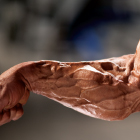 Q: What do you think about adding wrist curls to the end of an arm workout?
Q: What do you think about adding wrist curls to the end of an arm workout?
A: It’s a good idea—in fact, you might even consider doing them at the beginning of a workout! When bodybuilders complain that they can’t add mass or strength to their elbow flexors, I often suggest that they add some direct grip and forearm work.
Adding direct forearm and grip work to your workout regimen will make your curling poundages go up. You’ll find that forearm muscles such as the flexor carpi radialis contribute to elbow flexion. Consequently, strengthening the forearm muscles leads to enhanced biceps and brachialis development. That’s not a recent discovery—elite bodybuilders of the 1960s were known for having great forearms and being able to handle Herculean weights on curling exercises.
The late Chuck Sipes won the ’60 IFBB Mr. Universe and placed second to Sergio Oliva in the ’67 Mr. Olympia. At 5 ’9 1/2” Sipes had 19 1/2-inch arms. He said, “Every bodybuilder should work the forearms regularly as part of their workouts. I worked in sawmills and lumberjacking when I was younger, and this helped my development and strength quite a bit.” The bodybuilding legend practiced what he preached: Sipes could bench-press 570 pounds raw and perform barbell curls with 250.
In designing forearm workouts, I often superset two types of wrist curls with different forms of resistance to overload the entire strength curve, as follows:
A1) Palms-down dumbbell wrist curls,
2/0/1/0 tempo, 3 x 15-20
No rest
A2) Palms-down low-pulley wrist curls,
2/0/1/0 tempo, 3 x 15-20
Rest 120 seconds, go back to A1.
B1) Palms-up dumbbell wrist curls,
2/0/1/0 tempo, 3 x 15-20
No rest
B2) Palms-up low-pulley wrist curls,
2/0/1/0 tempo, 3 x 15-20
Rest 120 seconds, go back to B1
Editor’s note: Charles Poliquin is recognized as one of the world’s most suc-cessful strength coaches, having coached Olympic med-alists in 12 different sports, including the U.S. women’s track-and-field team for the 2000 Olympics. He’s spent years researching European journals (he’s fluent in English, French and German) and speaking with other coaches and scientists in his quest to optimize training methods. For more on his books, seminars and methods, visit www.CharlesPoliquin.com. Also, see his ad on page 131. IM




















You must be logged in to post a comment Login